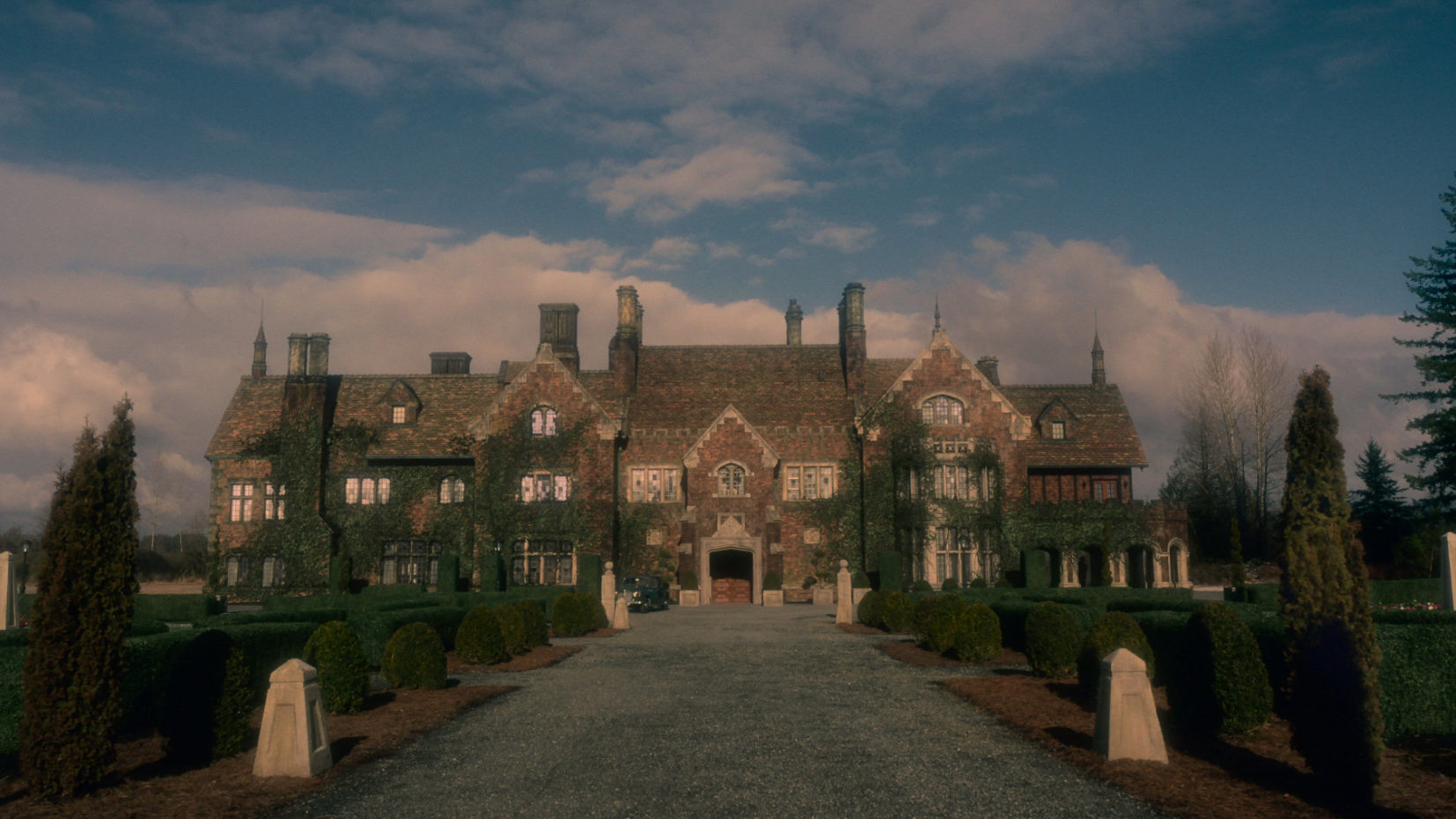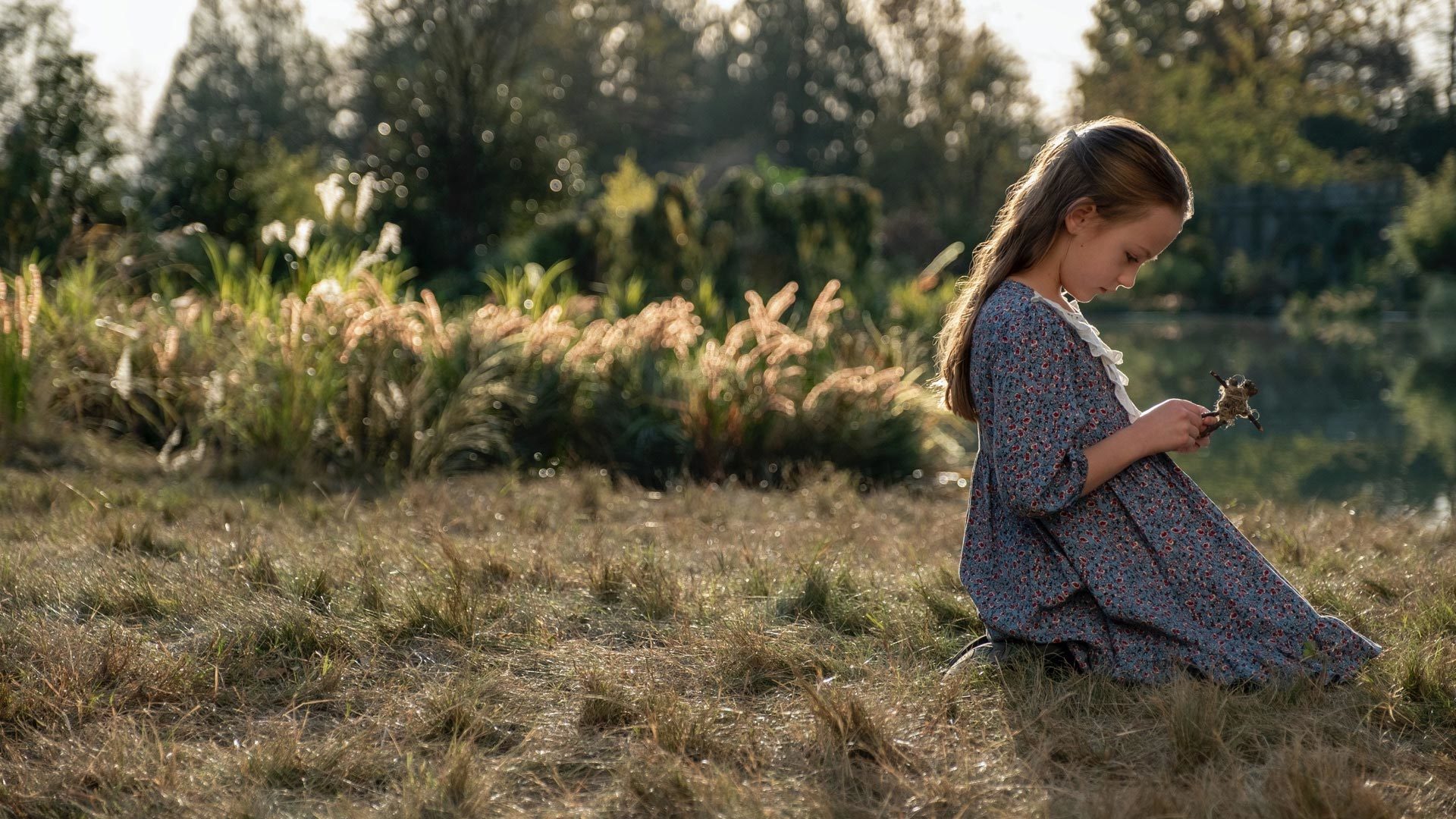
Unlike its predecessor, ‘The Haunting of Hill House’ (2018), Mike Flanagan’s signature second instalment focuses less on the dread and more on the emotional side of things. The ‘it’s not a ghost story, it’s a love story’ phrase has been around for quite a while, and it takes on a meaning of its own in ‘The Haunting of Bly Manor’ (2020). The original, ‘every love story is a ghost story’, can be found in a letter that David Foster Wallace wrote to the late Richard Elman back in 1986. Both expressions could easily fit within the walls of Bly Manor and make perfect sense.
I do enjoy the ghostly anthology style, and here’s to hoping that Mr Flanagan will undertake other such projects in the future. There are so many haunted places in this world, and so few artists who are truly equipped to tell these stories with adequate profundity and emotional intensity… it would be a shame not to produce more of this stuff.
 ‘THE HAUNTING OF BLY MANOR’ (2020), ©NETFLIX
‘THE HAUNTING OF BLY MANOR’ (2020), ©NETFLIX
While I understand that Bly Manor may have disappointed some viewers who previously applauded Hill House, a fraction of the blame can be placed on the marketing department. We went in expecting something else, but I found strange enlightenment in the end, an ‘Aha!’ sparkle that brought me back to the ‘love story, ghost story’ trope above. Truth be told, no respectable haunting was ever a gory horror tale with blood and guts and jump-scares. Ghosts are fingerprints of the past in our collective folklore, spectres who are unable to let go, even in death, and some of whom are able to influence the world of the living.
It means we have to deal with sadness, remorse, longing, and other equally consuming feelings that we experience in the presence of death and the absence of those we loved and lost. Therefore, a true ghost story has multiple dimensions. A good ghost story is able to break your heart, and Mike Flanagan does it in two different styles with both Hill House and Bly Manor. The former explores the grief and bitterness that suicide leaves behind. The latter studies love and its dysfunctions as they unravel under the influence of a spirit whose rage binds everyone to her. Both have mysterious, almost-sentient houses as leading characters.
 ‘THE HAUNTING OF BLY MANOR’ (2020)
‘THE HAUNTING OF BLY MANOR’ (2020)
Mike Flanagan has become a master of the genre with both limited series, but also with his work on Stephen King’s ‘Gerald’s Game’ (2017) and the more recent ‘Doctor Sleep’ (2019). His writing style has an almost poetic depth I’ve only seen in Shirley Jackson and Henry James, which is probably why he resonated so beautifully with these illustrious authors’ works. The focus is never really on the actual ghosts. After all, they tell the same story—unresolved issues, the inability to move on, the violence of their death which caused a bruising of the very fabric of existence… it’s always a broken heart at the centre of a haunting, somehow. No, the focus is on the living and on how they cope with loss, with misery, and with the supernatural elements that they never wanted to believe in.
‘The Haunting of Bly Manor’ simply does it with a sweeter tone. The ghosts have a more personal autonomy than those of Hill House. The living and the dead collide, repeatedly, between the walls of the English mansion, its rooms seemingly larger at night—as if the house itself inhales deeply and holds its breath until the light of morning. There is poetry in Carla Gugino’s storytelling monologues. I was pleasantly surprised by its added value, in fact, as I am not really a fan of narrators in moving pictures. Her repetitions have a dramatic effect, evoking the very loops of post-existence that ghosts seemingly go through. I doubt the series would’ve had the same effect without her. Sometimes, telling adds value to showing.
 ‘THE HAUNTING OF BLY MANOR’ (2020), ©2020
‘THE HAUNTING OF BLY MANOR’ (2020), ©2020
Some things could have been done differently, sure, but I wouldn’t dare dissect the series down to its bones for this because the transgressions are minimal, at most, and splendidly overshadowed by the extraordinary performances of its actors. Keeping in line with the anthology format we’ve seen before in Ryan Murphy’s ‘American Horror Story’, there are returning cast members who’ve changed their residence from Hill House to Bly Manor. Each of them is exceptional and remarkably versatile.
Victoria Pedretti brings tears to one’s eyes as Dani Clayton, a young woman struggling with her sexuality and a tragedy she feels personally responsible for. Her intensity is only matched by her emotional palette. Few manage to express true and unexpected terror when locked in a closet—few manage to make the viewers themselves take deep breaths to fight a growing sense of claustrophobia, of walls closing in. Dani is also at the centre of the love story that is the hidden heart of this series, able to explore the payoff after having endured incommensurable horrors at Bly Manor and able to bid her lover farewell when the time comes to carry the curse back to its roots.
 ‘THE HAUNTING OF BLY MANOR’ (2020), ©NETFLIX
‘THE HAUNTING OF BLY MANOR’ (2020), ©NETFLIX
Kate Siegel returns as Viola, the angry and faceless spirit at the root of this nightmare—the former lady of Bly Manor who found herself betrayed and enraged beyond the grave. Her vicious circle break hearts, over and over, as she goes through the motions and consumes everything in her path, even when there is no one left to remember her. Viola is proof that there is nothing worse than being forgotten. Not even death is worse than vanishing into the dark recesses of human history.
Oliver Jackson-Cohen and Henry Thomas came back, as well, as Peter Quint and Henry Wingrave, respectively. One is a deeply flawed but passionate man, and the other… well, they’re more or less the same, actually, despite their financial and societal differences. Carla Gugino is a delightful presence, her deep voice and melancholic gaze working seamlessly as a thread that pulls everyone and everything together.
 ‘THE HAUNTING OF BLY MANOR’ (2020), ©NETFLIX
‘THE HAUNTING OF BLY MANOR’ (2020), ©NETFLIX
Benjamin Evan Ainsworth and Amelie Bea Smith are both extraordinary as the children of Bly Manor. These sterling thespians are able to build their characters into three dimensions that mercilessly punch holes through one’s stomach. Miles and Flora are both odd—I believe they were written as such, while also trying to stay at least partially true to their age. It’s not an easy task to accomplish, but they both come through quite nicely. They’re ‘perfectly splendid’.
Rahul Kohli as Owen is a dollop of kindness and hope that is desperately needed, particularly in the darkest of times. His love story is the saddest, too, once you realize that he will never be able to bring it to a positive conclusion. But frankly, the true star of Bly Manor and a breath-taking performer that deserves her own crown is T’Nia Miller as Hannah Grose. Hers is the hardest tale to tell. It starts and ends in tears, yet it is filled with love and hope and mountains of empathy strangled by threads of lost time. If anyone ever wondered what being a ghost might feel like, Hannah is an exceptional point of reference.
 ‘THE HAUNTING OF BLY MANOR’ (2020), ©NETFLIX
‘THE HAUNTING OF BLY MANOR’ (2020), ©NETFLIX
The lasting impact of ‘The Haunting of Bly Manor’, much like its predecessor, comes from the brilliant combination of image and production design. The haunted house takes centre stage, of course, and to achieve a troubling effect evoking of Hill House, Mr Flanagan brought Patricio M. Farrell and art director Hugo Santiago back for Bly Manor. The ghostly Easter eggs, the period pieces, and the spine-tingling details… it all adds up to that subtle dread that’s meant to erode the resolve of everyone involved—characters and viewers alike.
To further strengthen the end result, Flanagan worked with Maxime Alexandre of ‘Annabelle: Creation’ (2017) fame and James Kniest, previously known for ‘Annabelle’ (2014). In an interview with Variety, Mr Kniest addresses the importance of using Hill House as a roadmap for Flanagan’s second Haunting foray.
 ‘THE HAUNTING OF BLY MANOR’ (2020), ©NETFLIX
‘THE HAUNTING OF BLY MANOR’ (2020), ©NETFLIX
Most of the story’s tone is eloquently captured in the screenplay and through the actors’ performances, but the style and camera language had to also match. With each Haunting, the camera work begins with static and symmetrical angles, gradually evolving into a more fluid and almost organic motion—we saw it in the funeral home with the Crains, and we see it again through the layers we peel away at in Bly Manor. The dark aesthetic delivers stupendously as the truth is gingerly revealed, painting tragedy with a fair palette.
 ‘THE HAUNTING OF BLY MANOR’ (2020), ©NETFLIX
‘THE HAUNTING OF BLY MANOR’ (2020), ©NETFLIX
At the end of the day, each viewer will make up their own mind regarding ‘The Haunting of Bly Manor’. They may voice discontent and point to insufficiencies whilst praising ‘The Haunting of Hill House’ as the superior of the two. It could go the other way around, as well. Or, better yet, each series will stand alone and with its distinctive set of features, while both pay homage to some of the best ghost tales ever written.
Whether it’s a love story or a ghost story or somewhere in-between, one truth remains. Our fascination with death and whatever might come afterwards is a timeless and endless source of hope and heartbreak.
Jules R. Simion
Jules is a writer, screenwriter, and lover of all things cinematic. She has spent most of her adult life crafting stories and watching films, both feature-length and shorts. Jules enjoys peeling away at the layers of each production, from screenplay to post-production, in order to reveal what truly makes the story work.
An Interview with Anna Drubich
Anna Drubich is a Russian-born composer of both concert and film music, and has studied across…
A Conversation with Adam Janota Bzowski
Adam Janota Bzowski is a London-based composer and sound designer who has been working in film and…
Interview: Rebekka Karijord on the Process of Scoring Songs of Earth
Songs of Earth is Margreth Olin’s critically acclaimed nature documentary which is both an intimate…
Don't miss out
Cinematic stories delivered straight to your inbox.
Ridiculously Effective PR & Marketing
Wolkh is a full-service creative agency specialising in PR, Marketing and Branding for Film, TV, Interactive Entertainment and Performing Arts.


